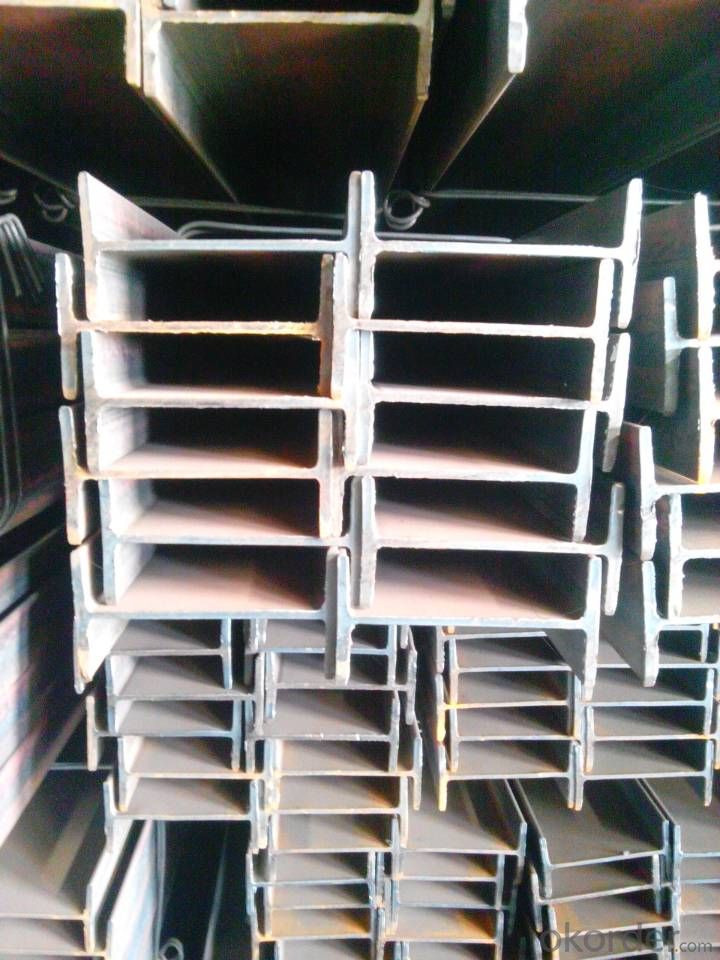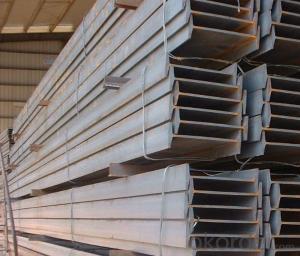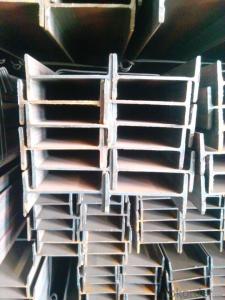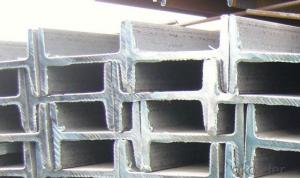Hot Rolled IPE and IPEAA Beams Grade Q235 Steel I-Beams
- Loading Port:
- Tianjin
- Payment Terms:
- TT or LC
- Min Order Qty:
- 25 m.t.
- Supply Capability:
- 10000 m.t./month
OKorder Service Pledge
OKorder Financial Service
You Might Also Like
OKorder is offering high quality Hot Rolled Steel I-Beams at great prices with worldwide shipping. Our supplier is a world-class manufacturer of steel, with our products utilized the world over. OKorder annually supplies products to European, North American and Asian markets. We provide quotations within 24 hours of receiving an inquiry and guarantee competitive prices.
Product Applications:
Hot Rolled Steel I-Beams are ideal for structural applications and are widely used in the construction of buildings and bridges, and the manufacturing, petrochemical, and transportation industries.
Product Advantages:
OKorder's Steel I-Beams are durable, strong, and resist corrosion.
Main Product Features:
· Premium quality
· Prompt delivery & seaworthy packing (30 days after receiving deposit)
· Corrosion resistance
· Can be recycled and reused
· Mill test certification
· Professional Service
· Competitive pricing
Product Specifications:
Manufacture: Hot rolled
Grade: Q195 – 235
Certificates: ISO, SGS, BV, CIQ
Length: 6m – 12m, as per customer request
Packaging: Export packing, nude packing, bundled
Chinese Standard (H*W*T) | Weight (Kg/m) | 6m (pcs/ton) | Light I (H*W*T) | Weight (Kg/m) | 6m (pcs/ton) | Light II (H*W*T) | Weight (Kg/m) | 6M |
100*68*4.5 | 11.261 | 14.8 | 100*66*4.3 | 10.13 | 16.4 | 100*64*4 | 8.45 | 19.7 |
120*74*5.0 | 13.987 | 11.9 | 120*72*4.8 | 12.59 | 13.2 | 120*70*4.5 | 10.49 | 15.8 |
140*80*5.5 | 16.89 | 9.8 | 140*78*5.3 | 15.2 | 10.9 | 140*76*5 | 12.67 | 13.1 |
160*88*6 | 20.513 | 8.1 | 160*86*5.8 | 18.46 | 9 | 160*84*5.5 | 15.38 | 10.8 |
180*94*6.5 | 24.143 | 6.9 | 180*92*6.3 | 21.73 | 7.6 | 180*90*6 | 18.11 | 9.2 |
200*100*7 | 27.929 | 5.9 | 200*98*6.8 | 25.14 | 6.6 | 200*96*6.5 | 20.95 | 7.9 |
220*110*7.5 | 33.07 | 5 | 220*108*7.3 | 29.76 | 5.6 | 220*106*7 | 24.8 | 6.7 |
250*116*8 | 38.105 | 4.3 | 250*114*7.8 | 34.29 | 4.8 | 250*112*7.5 | 28.58 | 5.8 |
280*122*8.5 | 43.492 | 3.8 | 280*120*8.2 | 39.14 | 4.2 | 280*120*8 | 36.97 | 4.5 |
300*126*9 | 48.084 | 3.4 | 300*124*9.2 | 43.28 | 3.8 | 300*124*8.5 | 40.87 | 4 |
320*130*9.5 | 52.717 | 3.1 | 320*127*9.2 | 48.5 | 3.4 | |||
360*136*10 | 60.037 | 2.7 | 360*132*9.5 | 55.23 | 3 |
FAQ:
Q1: Why buy Materials & Equipment from OKorder.com?
A1: All products offered byOKorder.com are carefully selected from China's most reliable manufacturing enterprises. Through its ISO certifications, OKorder.com adheres to the highest standards and a commitment to supply chain safety and customer satisfaction.
Q2: How do we guarantee the quality of our products?
A2: We have established an advanced quality management system which conducts strict quality tests at every step, from raw materials to the final product. At the same time, we provide extensive follow-up service assurances as required.
Q3: How soon we can delivery the goods ?
A3: We have a mill with 20000mts of capacity per month. We can delivery the goods within in one month ,as long as your order quantity less than 20000mts .
Images:


- Q:How do steel I-beams contribute to the overall safety of a structure?
- A structure's overall safety is enhanced in numerous ways by the presence of steel I-beams. To begin with, their design and construction make them exceptionally strong and capable of withstanding bending or twisting forces. Consequently, they are able to bear heavy loads and distribute weight evenly across the structure. By providing a robust and stable framework, steel I-beams decrease the likelihood of structural collapse, guaranteeing the safety of the occupants. In addition, steel I-beams possess a significant level of fire resistance. Since steel has a high melting point, it can endure elevated temperatures for longer periods compared to materials like wood or concrete. This fire resistance diminishes the risk of structural failure during a fire, allowing occupants more time to safely evacuate the building. Furthermore, steel I-beams are exceptionally durable and long-lasting, displaying a high resistance to corrosion and degradation. This ensures that the structure remains intact and stable over time, reducing the chance of sudden failures or collapses. The strength and durability of steel I-beams also make them less susceptible to natural disasters such as earthquakes or strong winds, further bolstering the safety of the structure. In conclusion, steel I-beams contribute to the overall safety of a structure through their provision of a strong and stable framework, high fire resistance, and durability. Their ability to withstand heavy loads, distribute weight evenly, and resist bending or twisting forces guarantees the structural integrity of the building, minimizing the risk of collapse. When combined with their fire resistance and durability, steel I-beams offer a reliable and secure foundation for a safe structure.
- Q:Are steel I-beams resistant to impact or blast loads?
- Steel I-beams are renowned for their exceptional strength and durability, rendering them highly suitable for a diverse array of structural uses. When it comes to withstanding impact or blast loads, steel I-beams generally demonstrate outstanding performance. Under the influence of impact loads, such as collisions or the descent of hefty objects, steel I-beams possess a formidable capacity to absorb and distribute the applied force. The structural attributes of steel, including its remarkable tensile strength and ductility, allow it to deform and absorb energy without incurring significant damage. As a result, steel I-beams exhibit greater resistance to impact loads when compared to alternative materials. In the same vein, steel I-beams also provide substantial resistance against blast loads, which encompass sudden and high-intensity pressure waves generated by explosions. The intrinsic strength and stiffness of steel empower it to withstand the dynamic forces that accompany blast loads. Moreover, the weight and rigidity of steel I-beams contribute to their capacity to counteract pressure and disseminate the energy unleashed by a blast. One must bear in mind that the specific resistance of steel I-beams to impact or blast loads can fluctuate based on factors such as the beam's size and design, the type and magnitude of the load, and the overall structural configuration. Consequently, conducting engineering analysis and considering design aspects are indispensable in ensuring the fitting selection and placement of steel I-beams that can withstand impact or blast loads in any given application.
- Q:How are steel I-beams manufactured?
- Steel I-beams are manufactured through a process known as hot rolling. This involves heating a large rectangular billet of steel until it becomes malleable and can be shaped into the desired I-beam profile. The billet is then passed through a series of rolling mills that progressively shape it into the final I-beam shape. The first step in the hot rolling process is heating the billet in a furnace to a specific temperature, typically around 1200 to 1300 degrees Celsius. This high temperature makes the steel more ductile and allows it to be easily formed. Once the billet reaches the desired temperature, it is fed into the first rolling mill. The rolling mill consists of a series of rollers that gradually shape the heated billet into the I-beam profile. The rollers apply pressure to the steel, causing it to elongate and take on the desired shape. As the billet passes through each set of rollers, it becomes progressively thinner and longer, with the top and bottom flanges of the I-beam taking shape. After passing through the initial rolling mill, the partially formed I-beam undergoes further shaping in subsequent rolling mills. These mills continue to apply pressure and refine the shape of the I-beam until it reaches its final dimensions. The final step in the hot rolling process is cooling the newly formed I-beam to room temperature, either by air cooling or water quenching. Once the I-beams are cooled, they are cut to the desired length and undergo any necessary additional processing, such as surface treatments or galvanization. They are then ready for use in various construction projects, where their strength and structural integrity make them an ideal choice for supporting heavy loads and spanning long distances.
- Q:How do engineers determine the appropriate size and type of steel I-beam for a project?
- Through a comprehensive analysis of various factors, engineers ascertain the suitable dimensions and kind of steel I-beam for a project. Initially, they evaluate the project's structural prerequisites, encompassing load-bearing capacity, span length, and expected loads such as permanent (dead) and temporary (live) loads. To establish the necessary size of the I-beam, engineers perform structural computations and apply engineering principles like bending moment, shear force, and deflection analysis. These calculations enable engineers to comprehend the forces and stresses acting upon the beam, facilitating the selection of an appropriate size that can adequately support the anticipated loads without failure. Moreover, engineers consider the type of steel I-beam based on the specific project requirements. Distinct steel grades offer varying degrees of strength, ductility, and resistance to corrosion. Engineers evaluate the environmental conditions, moisture exposure, and potential chemical influences to opt for a steel type that can endure these factors and maintain its structural integrity over time. In addition to structural considerations, engineers also factor in cost-effectiveness and the availability of the steel I-beams. Their aim is to strike a balance between meeting project requirements and minimizing unnecessary expenses. This entails considering the standard sizes and shapes accessible in the market, ensuring that the selected I-beam can be readily sourced and seamlessly integrated into the project without significant delays or additional costs. Overall, the determination of the appropriate size and type of steel I-beam for a project is a meticulous process that demands careful deliberation of the structural prerequisites, load calculations, material properties, and economic factors. Engineers leverage their expertise, knowledge of engineering principles, and relevant design codes and standards to guarantee the secure and efficient utilization of steel I-beams in construction projects.
- Q:How are steel I-beams connected in construction?
- Steel I-beams are typically connected in construction through welding, bolting, or a combination of both methods. Welding involves fusing the ends of the I-beams together using heat and a consumable electrode, creating a strong and permanent connection. Bolting, on the other hand, involves using bolts and nuts to secure the I-beams together, providing flexibility for future adjustments or disassembly if required. The specific method chosen depends on factors such as the structural requirements, load-bearing capacity, and design preferences of the construction project.
- Q:How do steel I-beams perform in areas with high humidity?
- Steel I-beams perform well in areas with high humidity. Steel is highly resistant to moisture and does not easily rust or corrode. However, it is important to ensure proper maintenance and protection to prevent any potential issues. This can be achieved by applying protective coatings or paint to the steel beams, which act as a barrier against moisture. Additionally, regular inspections and cleaning can help identify and address any signs of corrosion or damage. Overall, steel I-beams are a reliable and durable choice for areas with high humidity, as long as proper care and maintenance are provided.
- Q:How long is a ton of 10# I-beam?
- 10# I-beam is 10.007KG/ meters in weight and 99.930 meters in weight. 10# I-beam is 6 meters per foot. There is a need to call 029-89104110 calls, say you are Baidu, know the questioner, give you discount.
- Q:Can steel I-beams be used in railway bridges?
- Yes, steel I-beams can be used in railway bridges. They are commonly used in railway bridge construction due to their strength, durability, and ability to support heavy loads. Steel I-beams provide the necessary structural support for railway bridges, ensuring the safe passage of trains.
- Q:Can steel I-beams be used for billboard structures?
- Yes, steel I-beams can be used for billboard structures. Steel I-beams are commonly used in construction due to their strength and durability. They provide excellent load-bearing capabilities and can withstand heavy wind and weather conditions, making them suitable for supporting large billboards. Additionally, steel I-beams can be easily fabricated and assembled, allowing for efficient installation and maintenance of billboard structures.
- Q:What are the considerations for steel I-beam design in high-traffic areas?
- When designing steel I-beams for high-traffic areas, several considerations should be taken into account. Firstly, the load capacity of the beam should be carefully calculated to ensure it can withstand the weight of the traffic and any additional dynamic loads. Additionally, the beam's geometry, such as its depth and flange width, should be optimized to provide sufficient strength and stiffness. Corrosion resistance is also crucial, as high-traffic areas are often exposed to environmental factors that can accelerate rusting. Furthermore, the beam's connections and supports should be designed to ensure stability and minimize vibrations, which can affect the structural integrity and user comfort. Lastly, factors like fire resistance and noise reduction may also be important considerations depending on the specific requirements of the high-traffic area.
1. Manufacturer Overview |
|
|---|---|
| Location | |
| Year Established | |
| Annual Output Value | |
| Main Markets | |
| Company Certifications | |
2. Manufacturer Certificates |
|
|---|---|
| a) Certification Name | |
| Range | |
| Reference | |
| Validity Period | |
3. Manufacturer Capability |
|
|---|---|
| a)Trade Capacity | |
| Nearest Port | |
| Export Percentage | |
| No.of Employees in Trade Department | |
| Language Spoken: | |
| b)Factory Information | |
| Factory Size: | |
| No. of Production Lines | |
| Contract Manufacturing | |
| Product Price Range | |
Send your message to us
Hot Rolled IPE and IPEAA Beams Grade Q235 Steel I-Beams
- Loading Port:
- Tianjin
- Payment Terms:
- TT or LC
- Min Order Qty:
- 25 m.t.
- Supply Capability:
- 10000 m.t./month
OKorder Service Pledge
OKorder Financial Service
Similar products
New products
Hot products
Related keywords





























